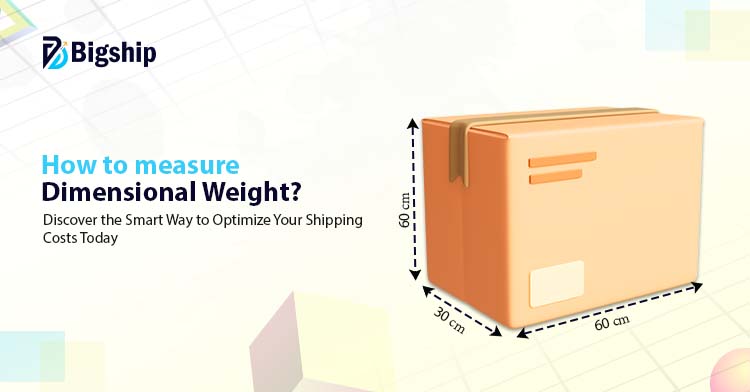Have you ever shipped a lightweight package but paid more than expected? This happens because shipping costs aren’t just about weight, they also depend on size. That’s where dimensional weight comes in.
Carriers use dimensional or dim weight to charge based on the space a package takes up, not just its actual weight. A big, light package can cost more than a small, heavy one. If you don’t calculate it right, you might end up paying extra.
Want to know what is dimensional weight and how to calculate dim weight? This blog covers everything you need to know about dim weight.
What is Dimensional Weight or Dim Weight?
Dim or Dimensional weight is the weight that decides shipping costs based on size and not just the actual weight of the product. Further, carriers charge for either the actual weight or dim weight, whichever is higher. This helps them manage space on delivery trucks.
For example, a large box of pillows is light but takes up a lot of space. A small box of dumbbells is heavy but compact. Even though pillows weigh less, their dimensional weight could be higher, thus, making them more expensive to ship.
How Does Dimensional Weight Pricing Work?
When you ship something, the cost isn’t just about actual weight. Dimensional weight also matters. Carriers compare both and charge based on the higher one.
Let’s say you pack a small gadget in a huge box. It’s light, but the box takes up space. Carriers can’t fit as many packages, so they charge based on dim weight instead of actual weight.
To avoid high costs, pack efficiently. Use smaller boxes to reduce dimensional weight and save on shipping.
How to Calculate Dim Weight?
When you ship a package, the cost isn’t always just about how heavy it is. Dimensional weight also comes into play. This is especially true if your package is light but takes up a lot of space. So, let’s talk about how to calculate dim weight and why it matters.
The formula of dim weight: Length × Width × Height ÷ Carrier’s DIM Factor
If this number is higher than the actual weight, it becomes the chargeable weight.
Steps to Calculate Dimensional Weight
Measure Your Package: First, you need to measure your package. Grab a tape measure and check the length, width, and height of the box. Be sure to measure the longest points, even if the sides are a little wonky.
Round Up the Measurements: If your measurements are in decimals, round them up to the nearest whole number. For example, if the height is 12.4 inches, round it up to 13 inches.
Multiply the Numbers: Next, multiply those measurements together: length × width × height. This gives you the cubic size of the box in inches.
Divide by the DIM Factor: Now, take the cubic size and divide it by the DIM factor (usually 139 for air shipments). This will give you the dimensional weight.
Example of Calculation of Dim Weight
Let’s say your box is 20 inches long, 10 inches wide, and 10 inches high.
Now multiply: 20 × 10 × 10 = 2,000 cubic inches
Divide by the DIM factor: 2,000 ÷ 139 = 14 pounds (approximately)
So, your dim weight is 14 pounds. If the actual weight of your package is only 11 pounds, the shipping company will charge you for 14 pounds instead.
Right-Size Packaging to Reduce Dimensional Weight Costs
Choosing the correct packaging can make a big difference when it comes to dimensional weight and shipping costs. Here’s how you can do it:
Select the right packaging: Match the size and fragility of your item to avoid extra costs. Bulky but lightweight items can increase dim weight, so use compact boxes or lighter options like padded or poly mailers.
Get expert advice at a shipping store: If you are unsure about packaging, visit a local shipping store. They can help you pick the right box size and recommend proper cushioning to prevent overpacking or underpacking.
Consult a packaging specialist: A specialist can suggest better packaging options to reduce waste, protect your product, and lower dimensional weight costs.
Why Does Dimensional Weight Matter?
Dimensional weight affects shipping costs and how efficiently packages are transported. Here’s why it matters:
Ensure Fair Pricing: Courier companies charges based on dim weight or actual weight, whichever is higher. This prevents lightweight but bulky packages from taking up too much space at a lower cost.
Optimizes Cargo Space: By using dim weight, carriers can fit more shipments in a truck or plane. This makes the transportation process more well-organized.
Reduces Wasted Resources: Efficient packaging lowers fuel consumption and cuts down on excess packaging materials. This helps reduce environmental impact.
Saves Money for Shippers: Packing smartly helps you avoid extra charges related to dim weight. Smaller and well-packed boxes can lower shipping costs.
Why Do Carriers Use Dimensional Weight?
Carriers use the dimensional weight to make shipping fair and efficient. If pricing was based only on actual weight, a large, lightweight package would take up valuable space while costing less to ship. That wouldn’t be practical for carriers.
By using dim weight, they can charge based on both size and weight. This helps them fit more packages in trucks and planes, manage fuel costs, and keep operations smooth. Before shipping, you must learn how to calculate dimensional weight so that you can choose the right-sized box and avoid extra charges.
How Dim Weight Impact Shipping Costs?
Shipping costs depend on the dim weight or actual weight (whichever is higher). If you are shipping a large but lightweight package, it takes up more space, so the dimensional weight is used for calculating the cost of shipping.
Suppose, a box of pillows may be light, but since it takes up more space, the carrier charges based on dim weight rather than actual weight. On the other hand, a small but heavy package, like a box of books, is billed by its actual weight.
Conclusion
Dimensional weight calculation can make a big difference in your shipping costs. If you ignore the dim weight, you might end up paying an unnecessary amount. By choosing the right packaging and understanding how its pricing works can help save your money.
Before shipping, you must always check whether your package will be charged on the basis of dim weight or actual weight. This way, you can adjust your packaging and avoid unexpected costs.
If you’re looking for a reliable shipping solution, Bigship simplifies the process by offering accurate pricing through its rate calculator. Now that you know about dimensional weight works, you can make smarter shipping decisions and keep your costs under control.
Sign up with Bigship and ship your goods based on fair pricing.
FAQs
What is dimensional weight?
Dimensional weight is the shipping cost based on the size of your package, not just its weight. It helps carriers charge fairly for bulky and lightweight items.
How do I calculate the dim weight?
To calculate the dim weight use the following formula:
Length × Width × Height ÷ Carrier’s DIM Factor (which is usually 139)
Why does dimensional weight affect shipping costs?
Dim weight affects shipping costs because carriers use it to account for space in transportation and help them manage fuel and operational costs effectively.


